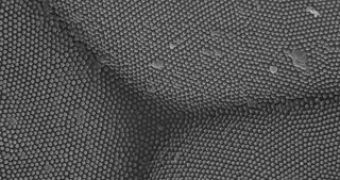Although people are accustomed to shiny solar panels and cells that are believed to replace conventional energy sources in the future, this is promised to change soon. In fact, scientists have discovered that, in order to improve the efficiency of the solar light caption devices, these need to be made as less reflecting and shiny as possible, according to Darren Bagnall, an engineer from the University of Southampton in Britain.
"Look at a solar cell at the wrong angle and you seem to get the whole sun reflecting back at you," states Bagnall, quoted by NewScientist. A silicon cell without a glass coating is able to absorb only about 66% of the light it receives from the Sun, while the glass cover that protects it reduces this capacity even more. In response to that, cells are designed with an anti-reflective blanket that traps the reflected photons among the incoming ones, but this process still allows for a great loss of energy.
Newly-developed solar cells also rely on this trapping property, but the scientists that designed them added another reflective layer that enhances the tangling characteristics, making the cells the best of their kind. The record-holding cells, created by a team of experts led by Martin Green from the University of New South Wales, Australia, feature a duller surface which allows for only a 3% reflection across the largest part of the visible and infrared spectra, thus being able to convert a quarter of the incoming light into electricity.
Shawn-Yu Lin and his team from the Rensselaer Polytechnic Institute in Troy, New York, have taken this reflection matter even further by conceiving an anti-reflective coating containing seven layers of silica and titanium dioxide which smoothen the regularly abrupt impact of photons on the cell's surface. The materials they use are cheap so that the cost of a cell thus produced is only about 4% higher, generating a reflection of just 4% across the visible and near-infrared spectrums, which he even hopes to improve.
Other approaches, such as Keith Barnham's from the Imperial College London, involve adapting the coating glass layer to the model of a moth's eye, which is built by nature so that it doesn't waste any light. His concept is comprised of a dense “forest” of spikes 500-nanometer tall, which can cut reflectance to 5% across the visible and infrared spectra.

 14 DAY TRIAL //
14 DAY TRIAL //